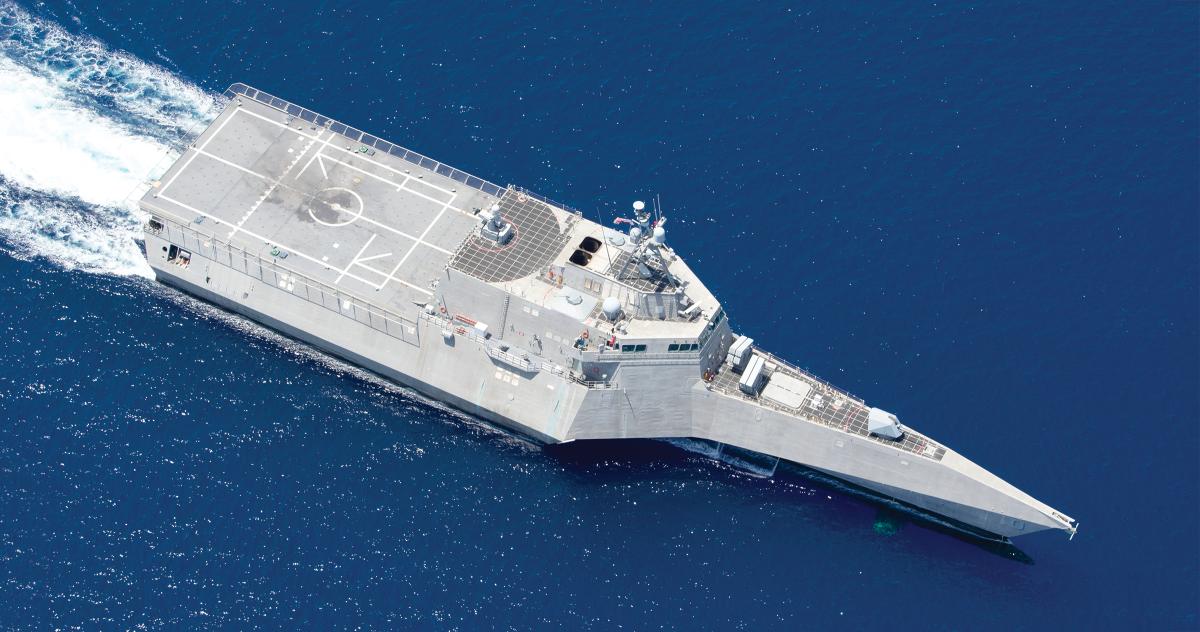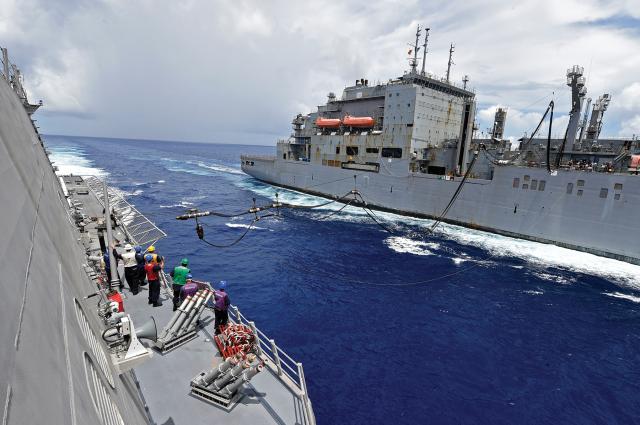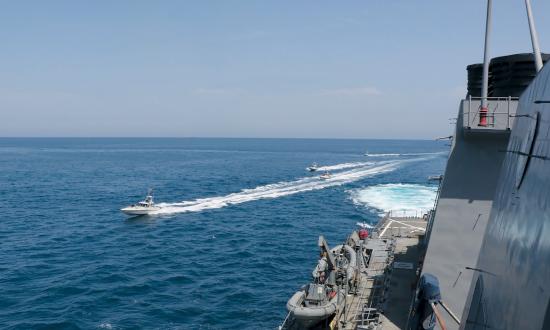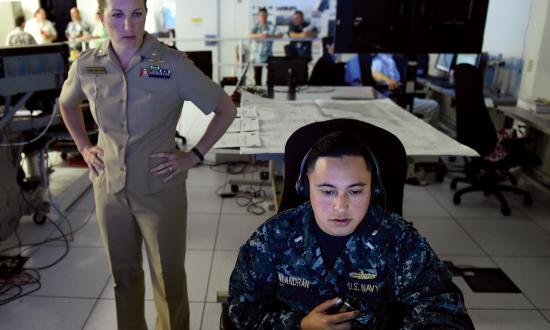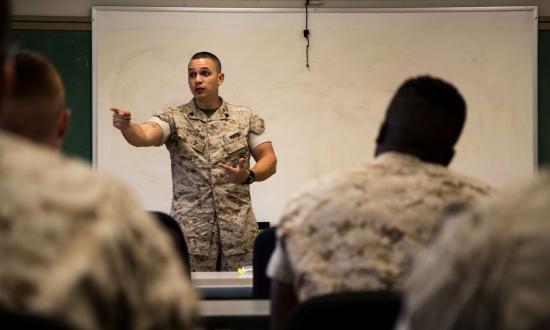The Independence- and Freedom-variant littoral combat ships (LCS) are each a significant departure from traditional ships, in terms of bridge watch-team composition, engineering and hull design, and maneuverability. The September 2020 Professional Note, “Driving Freedom-Class Littoral Combat Ships,” highlighted many of the departures in those ships. But the Independence variant has unique characteristics as well, ones that bear explanation to those considering a billet on or ordered to one.
Engineering and Hull Design
A waterjet system propels the Independence-variant LCS, with four steerable Wärtsilä waterjets at the stern and a retractable azimuthal (azi) thruster near the bow. A reduction gear couples each jet to a specific main propulsion engine—there is no complicated combining gear. Diesel engines power the outboard waterjets and gas turbines the inboard pair. The waterjets are located on the narrow center hull, minimizing the differences in turning capability between the engines. Unlike propellers that generate side force that turns the ship, waterjets have no side force and can turn the ship well in any direction.
Steerable and with reversing buckets, waterjets produce thrust vectors that can move the stern laterally with significant force, rapidly rotating the ship, while forward and aft thrust can be balanced to keep the ship stationary or at a required headway or sternway. Adding the azi thruster complements the motion of the stern for more maneuverability at low speeds, acting like a tugboat on the bow. If the azi thruster pushes the bow in the opposite direction from the stern, the twist rotation is faster and the turn radius even tighter. If the azi pushes the bow in the same direction as the engines are powering the ship, the ship can “walk” sideways at speeds greater than any other warship can without external assistance.
The Independence variant’s all-aluminum construction results in much less displacement than the ship’s volume and flight deck width would suggest. The long, narrow central hull allows for high-speed operations but is relatively unstable. The ship would be quick to roll when seas are near the beam, if not for the outer hull portions (referred to as “amahs,” from the Malay word for a domestic helper), which limit roll and keep the ship very flat during turns. At high speed, the amahs and control surfaces flatten the ride, one of the greatest benefits of the ship’s construction.
Watch-Team Dynamics
Both LCS variants’ bridge watch teams are much leaner than those of a traditional ship. Harbor pilots and other experienced merchant mariners frequently comment that an LCS bridge is more familiar to them—quieter and with responsibility concentrated in a smaller number of watchstanders.
On the Independence variant, the combat information center equivalent is called the interior communications center 1 (ICC-1) and is separated from the bridge team by only a retractable curtain. This promotes watch-team cohesion and the fusion of all sensor data to form a complete picture. Any bridge or ICC-1 watch-team member can communicate and walk a few steps to see a console or look out the window.
As on the Freedom-variant LCS, the officer of the deck (OOD) normally performs the roles of conning officer, helmsman, and lee helmsman, although a separate conning officer or combined helm and lee helmsman may be stationed for special evolutions to help the OOD manage the big picture. The Independence-variant combinators that control the waterjets are similar to the four on the Freedom variant, in that both versions pivot 30 degrees to either side, with throttle settings from 1 to 10 in either direction. However, on the Independence variant there are five—one for each waterjet and a fifth for the azi thruster, which can pivot 360 degrees and has throttle adjustment only in the direction the thrust will push the ship. The azi thruster can also provide emergency propulsion.
The four waterjet combinators may be operated independently, as port and starboard side pairs (2PS), inboard and outboard pairs (2L), or all together (4L). This provides great flexibility in accommodating various engineering plant configurations. The independent and 2PS modes provide the most flexibility and allow precise maneuvering for pier work and anchoring. The 2L and 4L modes are similar to maneuvering methods used on traditional screw-and-rudder ships. An important consideration in all steering modes, except 4L, is waterjet collision avoidance. The narrow central hull places the waterjets close enough that adjacent jets could collide if pointed toward each other at enough of an angle. Anticollision software prevents this by stopping steering response until the command position of the jets is corrected. Avoiding this condition is important, and during pier work the inboard jets are generally angled toward each other or “toed in” 10 degrees to allow the outboard jets full range of motion. Operating in 2PS provides more power for pier work, but the engines can be toed in only about 14 degrees on each side before anticollision stops them, reducing lateral thrust significantly relative to toeing out.
When precise turns are not required, autopilot frees the watch team from micromanaging bucket angle, so they can focus on other tasks. Autopilot may be used during normal underway steaming and underway replenishment, adjusting all four main combinators regardless of steering mode to control heading. Autopilot does not control engine power, so the OOD can carefully balance individual engine speeds to maximize efficiency. Autopilot adjustment for weather is important to balance steering response with fuel efficiency. Since thrust and steering angle are intrinsically linked on the Independence variant, waterjet movement has a significant effect on forward speed. A correctly set autopilot is demonstrably better than a human operator at minimizing excessive waterjet movement and keeping a steady course without losing speed.
The OOD and junior OOD (JOOD) relationship is similar to that of pilot and copilot in an aircraft. They have similar training and a communication style that optimizes task management and yields better understanding of a situation than what is achieved by many traditional watch teams. Teams naturally divide responsibilities, but on the LCS, console redundancy and extensive training for both OOD and JOOD mean each can rapidly assist the other when needed. There are two lookouts—one roving the bridgewings and pilothouse and another one aft watching astern. The voice data recorder (VDR) replaces the traditional paper deck log, but the JOOD remains ready to resume paper logging if the VDR fails. Chairs for the OOD and JOOD help reduce fatigue and provide easy access to keyboard and trackball controls for the consoles, but the team is not tied to these chairs. Moving to see out the window abaft the beams is necessary, as visibility is limited from the seats.
When watchstanders are on the bridgewing for a special evolution, primary communication with the pilothouse is done with a handheld radio. Sound-powered phones are available, but there are no amplifiers, and headsets are necessary. Cameras are available to monitor external views, including the flight deck as well as internal spaces, such as the mission bay for special evolutions. These cameras can be displayed on many consoles and are on overhead displays above the forward windows for ready reference.
The Physics of Movement
While most ships are constrained during pier work by having engines that act only near the stern, the Independence variant’s ability to control the bow makes pier work a matter of balancing lateral force on the bow and stern. The LCS OOD course in Newport, Rhode Island, teaches conning officers to adjust power on the azi thruster and balance this motion with the waterjets to set the pace of the lateral walk so heading is constantly maintained. The waterjets are split forward and astern to control any forward and aft motion. The conning officer has control of both ends of the ship and can move the pivot point as desired. The azi thruster rotates 360 degrees, but in pier work it is used only at 090 or 270 relative, set at a power to overcome external forces to move laterally at a safe speed. When it is extended, draft increases from about 15 to 20 feet and speed is limited to below 5 knots to prevent damage.
The Independence-variant always moors starboard side to the pier because of the location of the side door and quarterdeck. Prior to getting under way, the conning officer points the azi thruster to 090 relative at a low thrust setting to “pin” the ship to the pier. In most conditions, only the diesel waterjets are used for pier work. The gas turbines idle toed in 10 degrees to avoid collision alarms. The diesel waterjets are toed in about 10 degrees with an astern bell on the port engine, creating force vectors of 180 and 090 relative. The starboard waterjet toed in with an ahead bell creates a force vector of 000 and 090 relative, and the diesel waterjet’s power is balanced to achieve zero thrust forward or aft. The conning officer can look at the lines to ensure the effect. If all lines are slack, the forces are correctly balanced and the ship is not rotating or straining forward or aft. To walk off the pier, the conning officer turns the azi thruster to 270 relative. About 40 percent power will slowly move the ship against a 10-knot wind. The conning officer then toes out the waterjets to about 15 degrees without adjusting the ahead or astern bell, shifting their force vectors to 270 relative at the stern, and the ship walks sideways while maintaining its heading. Small corrections in heading or any desired forward and aft motion are made with one of the waterjets, usually the one thrusting in the direction the ship is traveling. A good practice is for conning officers to keep their disengaged hand in their pocket to avoid complicating things by changing more than one engine at a time.
Once the ship is laterally clear of hazards, azi thruster power is reduced and the toe angle of the waterjets decreased to counteract wind and current. Manipulating only one waterjet can usually accomplish this. To drive away from the slip, the conning officer should increase thrust on the waterjet pushing in the desired direction. This affects both the forward/aft and lateral vectors from that jet, and the conning officer must compensate accordingly. The azi thruster must be retracted prior to the ship exceeding 5 knots, but driving with engines alone above 3 knots is more effective. This propulsion allows control of lateral motion when going astern. Unlike a screw-and-rudder ship, where astern engine wash no longer flows over the rudder and the conning officer loses rudder authority, waterjets always provide a lateral vector. During training, students often find they are more comfortable driving with sternway than headway close to the pier.
At speeds below about 4 knots, a common technique is to keep one engine thrusting astern and one ahead, with the engine pushing the desired direction providing more power. This allows control of the stern down to any speed—bare steerageway becomes zero knots. In addition, by reducing power on the ahead jet, the conning officer can stop the ship without waiting for an engine to reverse. This makes precision anchorages easier to execute. Between 4 and 8 knots, the ship handles best with only one engine ahead.
One problem with waterjet propulsion is impeller cavitation. Cavitation on a traditional propeller causes noise and erosion, presenting tactical concerns but not immediate loss of propulsion. In a waterjet, higher impeller speeds exacerbate cavitation if speed through the water is insufficient to feed the jets. Cavitation is alerted to the operator by software and can be felt throughout the ship if the OOD pushes the engines too hard at low speeds. This reduces waterjet efficiency so significantly that thrust stalls and the ship loses speed. The OOD must carefully limit engine revolutions per minute (RPM) as speed increases to avoid cavitation.
Replenishment at Sea
The Independence variant’s trimaran hull influences behavior alongside an oiler in a helpful way. The lack of displacement at the amahs means the low-pressure zones between the hulls of the two ships are nearly 30 feet farther apart than are the actual refueling stations. This largely eliminates the Venturi effect, and the pressure zones between the two ships are less significant than with other ships. The only fueling station is located on the port side of the ship, near the aft end of the hangar, and is easily observable from the bridgewing.
Preparing an Independence-variant LCS to approach the oiler is similar to what is done in other ships. All available engines are brought online, and engine RPM for Romeo Speed (the agreed replenishment speed for both ships) is recorded in waterjet combinator control mode 4L. The radar is set up with parallel index lines at 180 feet/.03 nautical miles (nm) and 300 feet/.05 nm. A laser rangefinder is stationed on the port bridgewing. At waiting station, an OOD acting like a master helmsman takes the combinators, and the conning officer moves to the bridgewing. There, a gyro repeater allows the conning officer to use the Radian Rule to measure separation. An initial separation of 180 to 300 feet is acceptable and is closed to 180 to 200 feet once alongside.
When ready to make the approach, the conning officer orders the helm to shift control mode to 2L, allowing pairwise thrust control of diesel and gas-turbine engines while remaining in autopilot. One pair of jets is ordered to a T-6 throttle setting to make approach speed. When the OOD is ready to reduce speed, these engines are returned to the RPM recorded prior to the approach, approximating Romeo Speed. The engines are shifted to individual control and speed is fine-tuned with trim control joysticks next to each combinator. These joysticks allow small repeatable RPM changes without attempting to precisely move the stiff combinator lever. Maintaining position alongside the oiler is done the same as it is on other ships, making small adjustments as the ships move and respond to external forces. Using autopilot, with each engine’s thrust controlled individually, makes precise speed control possible, and a well-trained team may go as long as ten minutes alongside without adjusting course or speed.
The phone-and-distance line is typically anchored on the side of the LCS and hand tended on the oiler because of the limited number of personnel on the LCS. The line is tied off directly below the LCS bridgewing or on the bow. The bridgewing location is preferred, as the distance is closer to the actual separation between the two ships. The bow location requires math to account for the inboard location of the bow and may be at an odd angle from the oiler.
When ready to break away, the conning officer may open the distance between the two ships in a variety of ways. Once clear, control of engines is shifted to 4L and throttle setting is increased on all engines to clear the delivery ship. When safely clear, the OOD relieves both the conning officer and helmsman, resuming previous operations and an appropriate engineering plant configuration.
Preparing for the LCS
“Driving Freedom-Class Littoral Combat Ships” includes an excellent discussion of preparing for an LCS assignment. The control interface and behavior of both LCS variants are significantly different from traditional screw-and-rudder ships. They require junior officers to acquire new skills and not rely on traditional ship behaviors learned during first sea tours. I cannot emphasize enough to junior officers the benefit of engaging early with their future LCS commands and observing LCS shiphandling in a simulator prior to attending an LCS shipdriving course.
The excellent LCS OOD and JOOD courses do well in preparing junior officers for adapting to LCS shiphandling. The scope of the LCS OOD course goes beyond shiphandling, however, and provides instruction in weather, bridge resource management, and hydrodynamics. Concentrating shiphandling responsibility in fewer watchstanders leaves less margin for error, but the high standards of the training pipeline and frequent simulator practice go a long way toward ensuring future watchstanders are successful. I wish a similarly well-packaged course existed when I was an ensign. Fortunately, Surface Warfare Schools Command’s new OOD Phase I and II courses include valuable lessons from the LCS community to better prepare the next generation of surface warfare officers.



